
Kabob Koobideh (کباب کوبیده) is made with ground lamb or beef or a combination of the two. This is one of the most popular kabobs you can find on the streets of Iran. This Kabob is usually grilled over hot coals and is served in fancy restaurants and clubs, as well as in the little shacks scattered in any given recreation park. You can also find this kabob by following your nose in search of the source of the most heavenly aroma that fills the street or the indoor bazaar.
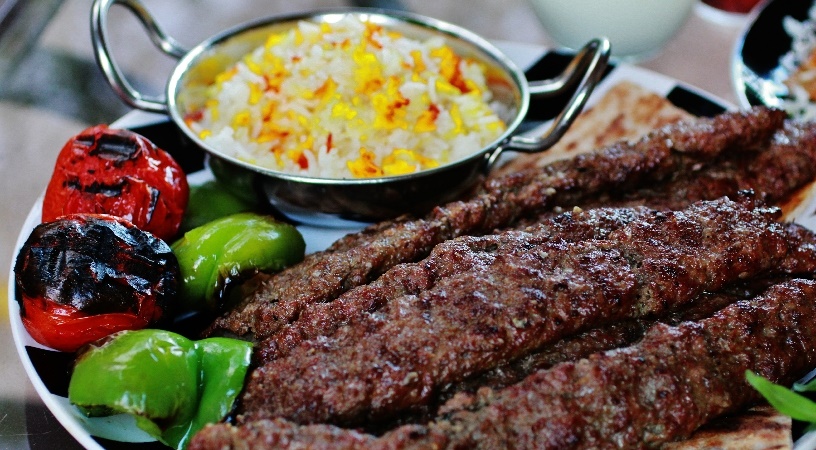
The aroma will lead you to a vendor, or as we call “Kabobi” (the Kabob Guy) with very modest equipment that sometimes can be as simple as a small charcoal grill and a bowl of ground lamb mixed with chopped onions and spices.
He will also have plenty of lavash or Sangak (thin Persian breads) on the side to make a quick wrap with the kabob right off the grill and maybe a grilled tomato with a slice of raw onion. Believe it or not the Kabob Koobideh grilled in these tiny little grills on the street corner smells more mouthwatering than any kabob served in fancy restaurants. No matter how sophisticated a restaurant menu, good Kabob Koobideh is as popular as any kabob offered on the menu and it is usually served with Persian Steamed Rice. In some restaurants this kabob is served side by side with a skewer of Kabob Barg (filet mignon kabob) and the dish is called Kabob Soltani, meaning fit for a soltan!
In our house Kabob Koobideh is served with Persian Steamed Rice and Sangak. A piece of Sangak is used to pull the kabob off the skewer and then divided among guests to enjoy. Hot kabob juices make the Sangak quite a desirable delicacy!
My Kabobi guy is my husband who has perfected his kabobs and this is his delicious recipe and technique. The technique to making kabobs is just as important as the recipe, if not more. No matter how great a recipe if the technique is not done correctly the outcome is going to be disappointing to say the least! I will be explaining his technique step by step, but I also want to mention one simple but important device that he uses when he grills kabobs. He places two hollow square metal pipes, purchased from hardware store, across the top and bottom of the grates so the meat grills without direct contact with the hot surface.
Finely chop the onion in the food processor. Transfer to a sieve and press on it with a spoon to drain all the liquid. Discard the liquid and mix the onion pulp with the ground meats
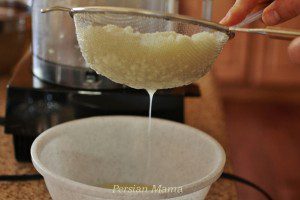
For best results make this kabob with fresh ground beef and lamb, not previously frozen, in room temperature. Mix the meat and onion pulp with the rest of the ingredients and knead with your fingers
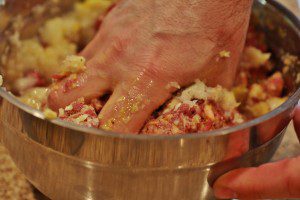
After kneading the mixture for a few minutes it will resemble a paste that will stick together and will not fall apart when you pick it up in your hand.
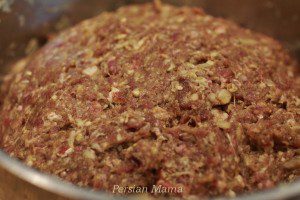
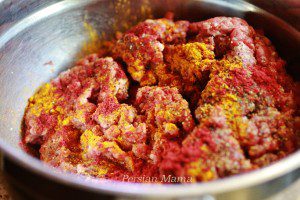
Make a ball with the mixture and place a 1-inch wide metal skewer on it, then start spreading the meat on the middle section of the skewer by opening and closing your fingers to stick the mixture securely to the skewer. Leave a few inches from the tip and handle section of the skewer clear for grilling. The thickness of the meat mixture should be about 1/2 inch all around the skewer.
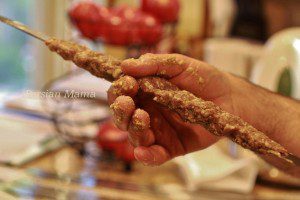
Press the meat between your thumb and index finger to make several indentations about 1 inch apart. Arrange the prepared Kabobs on a shallow tray with raised sides or a baking dish, so the meat does not touch the surface of the pan.
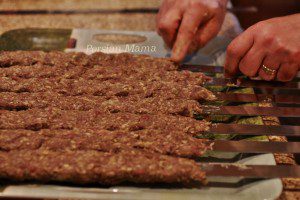
Narrow skewers work better than wide ones for the vegetables. The vegetables take longer to get ready, so if there is enough room on the grill start with the vegetables and halfway through grilling add the kabob skewers. If the space is limited, grill the vegetables first and keep them warm until Kabobs are done. The kabobs are going to take only minutes to grill. Arrange the kabobs on the grill (over the two previously mentioned metal pipes) and then right away start turning them in the order that they were placed; meaning, start turning the first skewer that was placed on the hot grill and continue with the rest of the skewers. The reason for this is that if one side of the kabob cooks through when you try to turn it, the uncooked part is going to fall off. Once the kabobs are grilled on both sides, you can turn them again until they are grilled to your taste.
Traditionally Kabob Koobideh is served with hot Persian Steamed Rice tossed with cubes of butter (room temperature) and sprinkled with Sumac. The drink of choice is usually Doogh (Persian Yogurt Drink) sprinkled with dried Persian Kakooti (an herb with a taste similar to Greek oregano or thyme that grows wild in the foothills of some areas of Iran). Persians love their Chelokabob (Rice and Kabob) with slices of raw onions (red or white) and fresh herbs (Sabzi Khordan). The golden beauties on the top right corner are pieces of TahDig which is the beloved crispy Lavash bread toasted in the bottom of the pot of Persian Rice.
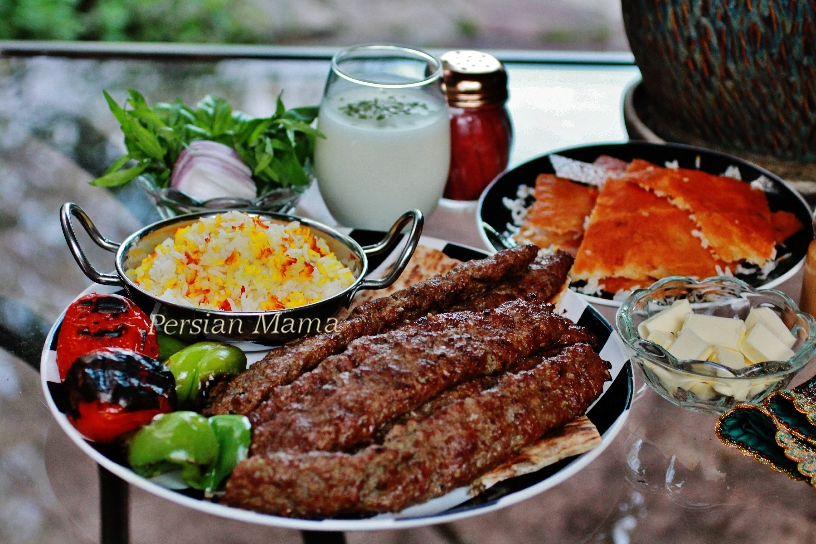
Salad Shirazi
This colorful refreshing salad is called Salad Shirazi, which is a Persian cucumber and tomato salad. Shirazi means from Shiraz, which is a beautiful city in southwestern Iran. It is the capital of Fars Province with friendly people, impressive historic sites and enchanting flower gardens. Among the many historic monuments in Shiraz frequented by tourists, are the memorials built for the two of the most famous Iranian poets, Hafez and Sadi whose books of poems are found in most Persian households and are translated to different languages
INGREDIENTS
3 small Persian cucumbers or 1 English cucumber, unpeeled
3 ripe, firm Roma tomatoes
¼ medium red onion
2 TBSP thinly sliced sweet or hot green pepper (no seeds)
3 TBSP roughly chopped fresh cilantro (may also use fresh parsley, dill, or mint instead)
DRESSING:
⅓ tsp kosher salt
¼ tsp freshly cracked black pepper
¼ tsp fine lime zest
3 TBSP fresh squeezed lime juice (about one medium lime)
2 TBSP olive oil
INSTRUCTIONS
1. Dice the cucumbers, tomatoes and red onion into small cubes. Add to a medium bowl.
2. Remove the seeds from the green pepper and slice very thin. Add to the bowl.
3. Add the chopped cilantro.
4. In a small bowl use a whisk to combine the lime juice, lime zest, salt, pepper and olive oil.
5. Add to the salad ingredients. Toss gently to coat. Serve immediately.
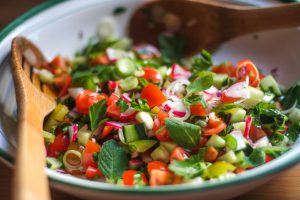
thanks from persianmama website